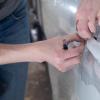All-Terrain Tyres vs Off-Road Tyres; What's the Difference?
This is one basic question we ask ourselves before buying a new replacement tire for our car. If your car just runs daily on just a clean paved road, choosing a tire replacement is really easy. But it is a different story when your travel routine is a mixture of the paved and off-road daily rides. We all want to buy something that can serve us multiple functions in one, so here are some quick simple pieces of knowledge that might help you gain an informed decision before buying your next new set of tires.
UNDERSTANDING DIFFERENT TIRE TREAD FUNCTIONS
Different type of tires varies mainly on their different tire “tread designs or patterns”. Each tire tread design then serves different functions. It could either be “symmetrical” meaning the inner half of the tire tread design is identical to the outer tire design, which is mainly designed for smooth driving, better stability, and having a lower rolling resistance. Next is the “directional” tread design pattern, which leans towards better water propelling function, better mud and snow handling, and good road grip at high speeds. Lastly, is the “asymmetrical” tire tread patterns, this pattern, on the other hand, are quite different because the inner tire design varies from the outer design of the tire tread pattern, this design is geared towards stability on high curves and provides better grip in wet surfaces.
All-terrain tires have tread patterns that focus more on the on-road performance than off-road performance, the all-terrain tires usually have a symmetrical tire tread design. And almost All-terrain tires have tread block design closely grouped together mainly to reduce road noise, and mostly it also has more “siping” in them. In case you did not know, “tire sipes” are the thin slices or grooves in your tire, these are precisely cut to improve tire traction for driving in wet, snowy, or even icy conditions. So then ask yourself, if your daily drive is mainly on a clean pavement and just occasionally do get off the pavement with some light to moderate off-road experience, then all-terrain tires suites you best.
Now, if you are spending your time driving on both the paved and off-road out in the trails with harsh conditions and more aggressive terrains, then the best choice is the off-road set of tires. You might be confused about the terms “rugged terrain tire” or “hybrid terrain tire” type of tires, mainly they are the same, the reason they call hybrid/rugged terrain is because the tread pattern design is in the combination of both half all-terrain and the other half is mud terrain tread design. The tread blocks in this type of tire are larger and blockier than your average all-terrain tires, and also have a lot of siping throughout the tread block in the tire. You might also hear about “tread voids” basically the term refers to the tread block gaps on your tire. Off-road / hybrid / rugged tires have a much larger tread void giving it much wider spaced treads for better traction and also because this design increases the evacuation capacity of snow, water, mud, sand, and dirt. Even though the tread design of a hybrid tire is much larger than it looks it is still designed leaning towards lesser road-noise, great stability cornering, and acceleration performance. So, if your daily drive is a mixture of off-road, and on-road routine drive, then a hybrid or rugged terrain tires are the best choices.
Now, speaking of “mud terrain” tires, this type of tire on the other hand as the name speaks for itself yes, you guessed it! These tires are the best for people who spend the majority of their drive going off-road scenarios and harsh terrain driving rather than on-road use. Mudd-tires terrain really have a difference when it comes to tire tread design, it has really large blocky tread lugs because it is really engineered in a way that favors off-road use rather than just paved street performance. The down is, that when you use mud tires on the pavement it produces more noise and is really not good handling in terms of speed. Tread block on mud tires has a scooping shape design to improve digging, grip, and bite even in worst ground scenarios. Mud tires have much larger tread voids in between the tread blocks for efficient evacuation of loss debris like sand, mud, and dirt. Also, take note, mud terrain tires have no tread siping which all-terrain tires and hybrid tire has therefore, it is not highly recommended for you to use mud-terrain tire in an icy terrain condition. Mud-terrain tires weigh a heavier because the tire is manufactured to be more resilient to cuts, tears and punctures which then compromise speed and fuel efficiency.
Lastly, is the compound of each different type of tires. All-terrain has better and long-lasting tire compounds compared to mud-terrain tires which have a lot softer compound design for more grip performance.
Just to review, if your driving time dwells more on just the pavement and you don’t need to worry about occasional off-road use then go with the all-terrain type. On the opposite, if your drive or hobby is to go mainly on off-road and extremely tough terrain situations, I would go with mud terrain. If it is a mixture of both worlds then go for the hybrid/rugged terrain tires.
More to Read:
Previous Posts:



